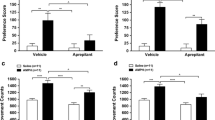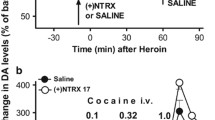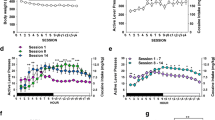Abstract.
Rationale: Mesolimbic dopaminergic neurotransmission plays a critical role in the locomotor effects of psychostimulant drugs, but a general involvement in the induction of long-term psychostimulant sensitization is questionable. By influencing dopaminergic neurotransmission, opioid drugs can alter the behavioral effects of psychostimulants. Objectives: The effects of the κ-opioid receptor agonists bremazocine, U69593, and U50488H on the locomotor stimulant and the long-term sensitizing effects of amphetamine and cocaine were investigated in rats. Unlike U69593 and U50488H, bremazocine is also an antagonist at µ- and δ-opioid receptors, as well as an agonist at a subtype of δ-opioid receptors inhibiting dopamine D1 receptor-stimulated adenylate cyclase. Methods: Bremazocine, U69593, and U50488H were administered prior to amphetamine and cocaine, and locomotor activity was measured. In separate studies, the opioids were co-administered with amphetamine and cocaine for 5 days, and locomotor sensitization was assessed 3 weeks post-treatment. Results: Bremazocine and U69593 attenuated the psychomotor stimulant effects of amphetamine and cocaine. U50488H attenuated the locomotor effect of cocaine and biphasically affected amphetamine-induced locomotion, i.e., suppression followed by stimulation. Bremazocine prevented the development of amphetamine-induced but not cocaine-induced long-term sensitization. Neither U69593 nor U50448H affected the induction of long-term amphetamine or cocaine sensitization. Conclusions: In agreement with previous studies, the present data suggest that differential mechanisms underlie the acute stimulant versus the long-term sensitizing effects of psychostimulants, and the induction of long-term sensitization by amphetamine versus cocaine. Stimulation of κ-opioid receptors does not seem to block the induction of long-term psychostimulant sensitization. Thus, bremazocine is likely to block the induction of amphetamine sensitization through a non-κ-opioid receptor mechanism. We suggest that this effect of bremazocine is the result of its unique agonist action at a subtype of δ-opioid receptors, thereby acting as a functional dopamine D1 receptor antagonist. This would be consistent with the literature showing that the induction of long-term amphetamine sensitization depends on the activation of dopamine D1 receptors. In addition, the present data are in keeping with studies showing that dopamine neurotransmission is not critical for the induction of long-term cocaine sensitization.
Similar content being viewed by others
Author information
Authors and Affiliations
Additional information
Electronic Publication
Rights and permissions
About this article
Cite this article
Vanderschuren, L., Schoffelmeer, A., Wardeh, G. et al. Dissociable effects of the κ-opioid receptor agonists bremazocine, U69593, and U50488H on locomotor activity and long-term behavioral sensitization induced by amphetamine and cocaine. Psychopharmacology 150, 35–44 (2000). https://doi.org/10.1007/s002130000424
Received:
Accepted:
Issue Date:
DOI: https://doi.org/10.1007/s002130000424




